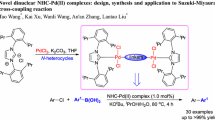Summary.
Palladium(II) complexes of the general formula PdCl2 (PR3)2 with PR3 = { P(OPh)3}, P(O-4-MeC6H4)3, P(O-2-MeC6H4)3, and PPh2(OBu) were reduced by NEt3 in chloroform or benzene to Pd(0) complexes Pd(PR3)4 and Pd(PR3)x(NEt3) 4−x . The same reaction performed in the presence of air gave CH3CHO or CH3CH2CHO when NPr3 was used instead of NEt3. Pd(P(OPh)3)4 reacted with benzyl bromide affording the oxidative addition product cis-PdBr(CH2Ph)(P(OPh)3)2. The reaction of PdCl2(P(OPh)3)2 with benzyl bromide was observed only in the presence of NEt3, and a dimeric complex of [PdBr(CH2Ph)(P(OPh)3)]2 was identified as the reaction product. Both benzyl complexes reacted fast with CO (1 atm) to form acyl complexes exhibiting ν(CO) bands at 1709 and 1650 cm−1.
Similar content being viewed by others
Author information
Authors and Affiliations
Rights and permissions
About this article
Cite this article
Trzeciak, A., Ziółkowski, J. Palladium Chemistry Related to Benzyl Bromide Carbonylation: Mechanistic Studies. Monatshefte fuer Chemie 131, 1281–1291 (2000). https://doi.org/10.1007/s007060070007
Issue Date:
DOI: https://doi.org/10.1007/s007060070007




